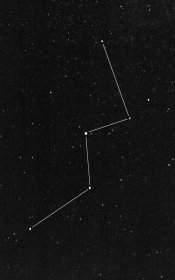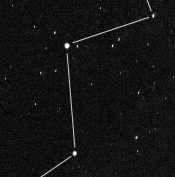Update.. this has been allot of fun and educational... two nights ago we had some cloud cover come in, and I tried with the lens wide open.. one @ 30 seconds and another @ 1 minute.. anyway. Just to see if anything would appeared. Even if it where blurred.
I had cut a 4x5 sheet, to make two MF negatives, and then used an old exposed 4x5, that I had cut up, to fill in front and in back of the 'live' MF size negative, so that it would sit in the middle of the 4x5 holder, and stay locked in.
Well we developed the two, HP5+ in D-76 for 18min for a 1600 ASA exposure, and couldn't really tell, if I had any stars at all, as there was no reference for the exposure, as I was shooting at the Azimuth, and angle recommended by the site. There was no surrounding foliage or silhouettes. DA.. concentrating so much on the sky, forgot the rest of the story. Ha... so the spots on the negative, that I had, I could not tell if they where just dust or what. But I suspect there was nothing.
Last night, again tried.. and the night was clear, and this time with the naked eye could see many more stars, yet looking on the ground glass.. could see nothing!!! When I moved the camera to the big dipper I could see some faint light.. but that's not the direction that they recommended. So set the camera back, Azimuth 316* Altitude 50.5*
Now normally one would use a wide angle lens for night shooting, and that makes allot of sense, but I'm wanting to see how much of the night sky these, two 35cm/12.5 Protar Ser. Vll cells, will cover, as combined they make, a 205/6.3 lens.
Why, because if the meteorite shower is a good one, and if I can get
still back round stars, it will make a better shot.. me thinks.. one crazy man's opinion. That's if I'm lucky and a meteorite shows up in the correct space and place!
So last night I shot two shots again.. and wanting to be sure to get an image.. shot for 14 minutes for the first and 7 minutes for the second.
We got tails.. But tails is not what I want, but as shown below,for the 7 minute one, they are strong and bright, and a lot less confusing then the 14 minute exposure.
Now remember I couldn't see any light of the stars at this location on the ground glass, so although its a no nothing shot.. the film saw it.. and that's what counts, so on to the next effort. What crazy fun,




 and took two shots.. using an exposure guide I got off the web, shot wide open.. first one for 30sec the next for 60sec
and took two shots.. using an exposure guide I got off the web, shot wide open.. first one for 30sec the next for 60sec




